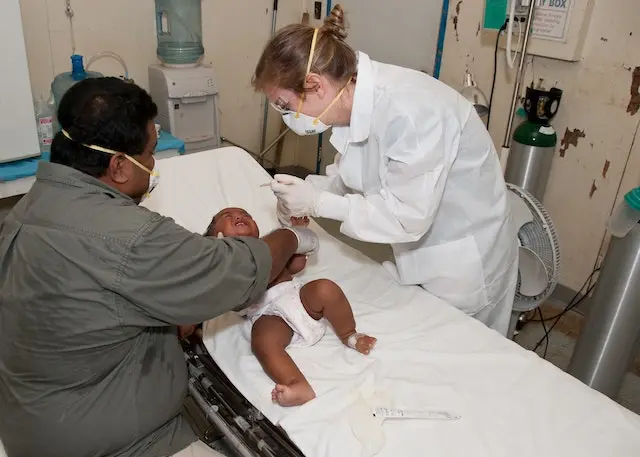Newborns are the most delicate creatures in every species. Human babies also have very fragile frames and need extra care. An infant in cardiac arrest needs immediate attention and medical help. Every person working in the NICU should take life-saving courses. CPR in the NICU guide talks about the correct way to deliver CPR to newborns. This blog also discusses more about the NICU and CPR for newborns.
Unique Challenges for CPR in the NICU
Neonatal intensive care units (NICUs) are specialized hospital units that care for premature and critically ill infants. CPR in the NICU can be challenging for several reasons, including:
- The Size Of The Infants: Neonates are much smaller than adults, so their airways are also smaller. It makes it more difficult to perform CPR effectively.
- The Fragility Of The Infants: Neonates’ skin is very delicate, so it is essential not to cause any injuries during CPR.
- The Presence Of Medical Devices: Many neonates in the NICU are hooked to ventilators and other medical devices. These devices can make it difficult to perform CPR effectively.
Techniques and Adaptations for Infants in the NICU
The techniques and adaptations for infants in the NICU vary depending on the infant’s size and condition. However, some general methods and adaptations include:
- Using A Smaller Chest Compression Device: Chest compression devices that are too large can cause injuries to the infant’s ribs. A correct size device will allow for more effective chest compressions without causing damage.
- Using Gentle Pressure: The pressure during chest compressions should be soft enough to avoid causing injuries but firm enough to circulate blood. The pressure will vary depending on the infant’s size and condition.
- Using A Bag-mask Device: A bag-mask device can be used to deliver breath to the infant. This device can be used with chest compressions to provide cardiopulmonary resuscitation (CPR).
- Administering Medications: Medications may be issued to the infant to help support their heart and lungs. These medications can be administered through an IV or a breathing tube.
- Experienced Team: Having a team of experienced healthcare professionals present is crucial. CPR in the NICU is often a team effort, and it is essential to have a couple of experienced healthcare professionals present to help ensure that the infant receives the best possible care.
In addition to these general techniques and adaptations, some specific methods may be used for infants in the NICU. These techniques include:
- Neonatal Advanced Life Support (NALS): NALS is a specialized type of CPR that is designed for infants. NALS includes specific techniques for chest compressions, breaths, and medications.
- Intraosseous (IO) Infusion: An IO infusion is a way to administer fluids and medications directly into the bone. It can be a lifesaving procedure for infants in the NICU who are in cardiac arrest.
FAQs
What should I know when giving CPR to a newborn?
You must remember that infants and neonates have weaker bone structures. Their bodies cannot take as much pressure as adult’s for chest compressions. You should also know about the two-finger chest compression method for children. Also, remember that neonates cannot be given rescue breaths with the same intensity as adults.
What is Infant CPR and its four steps?
Infant CPR is a medical procedure to help an infant without breathing or whose heart has stopped beating. It is a lifesaving procedure that anyone can perform, even if they have no medical training.
The four steps of infant CPR are:
- Check For Responsiveness: Gently shake the infant’s shoulder and shout, “Are you okay?” If the infant does not respond, call 911 immediately.
- Check For Breathing: Place your ear near the infant’s mouth and nose and look for chest movement. If the infant is not breathing, begin chest compressions.
- Perform Chest Compressions: Place two fingers n the middle of the chest and push down fast. Compress the chest 100 times per minute, using your body weight to apply pressure.
- Give Them Rescue Breaths: After every 30 light compressions, give two rescue breaths. Seal your lips around the infant’s mouth and nose to provide a rescue breath, and blow gently. Continue CPR until help arrives. Continue CPR until help comes or the infant starts to breathe independently. If an AED is available, use it as directed.
How fast should the rate of CPR be for Neonates?
The rate of CPR for neonates should be 100 to 120 chest compressions per minute. This is a faster rate than for adults, as neonates have smaller hearts and lungs that need more oxygenated blood. The chest compressions should be deep enough to compress the chest one-third to one-half of its depth.
Conclusion
A person looking after neonates must stay extra cautious. They must remember the crucial steps for infant CPR in the NICU guide. The American HealthCare Academy offers courses that cover infant and child CPR. You can work with ease in a challenging NICU after completing this course. Register on our website today for more details about the course and discounts.






